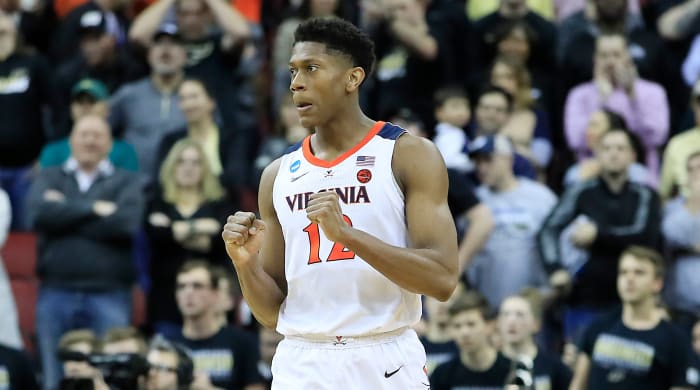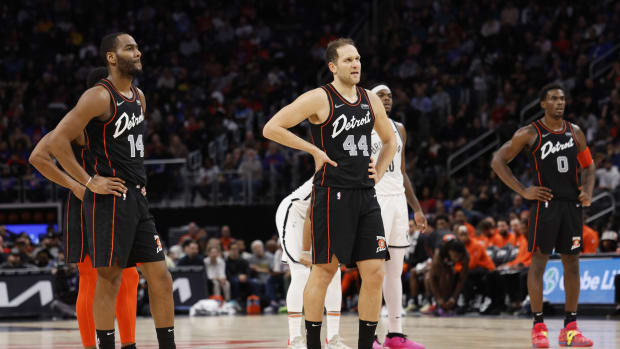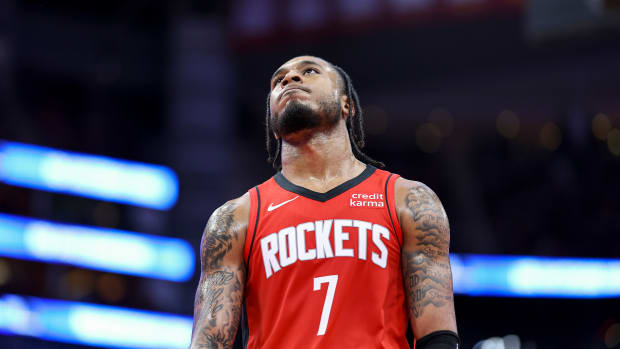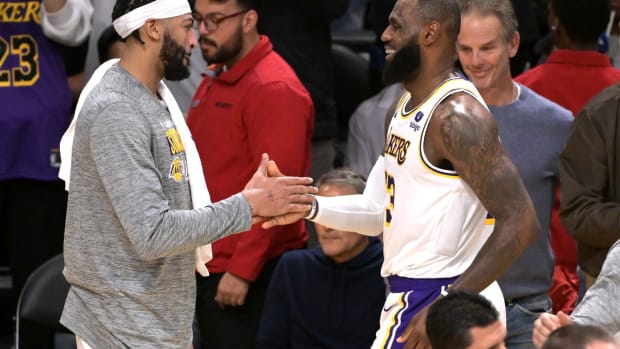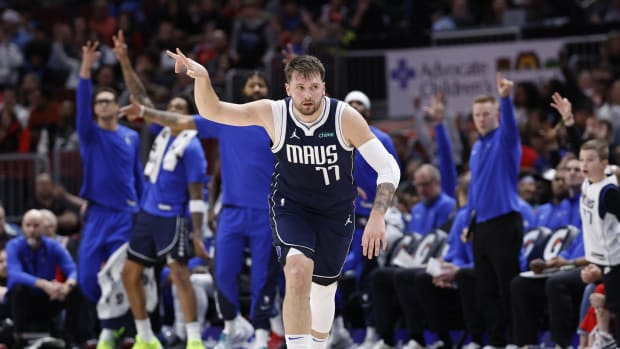Analyzing NBA Draft Prospects With Overinflated Stocks
With the draft nearing, and months of analysis in the bag, it’s more or less clear from our rankings how I feel about the available prospects. In the case of players I’m a bit more cautious about relative to where they might actually be drafted, it’s probably worth an extra layer of explanation and reasoning.
My trepidation in each case has been echoed by each prospect’s placement on our Big Board (which we’ll update again after the May 29 NCAA withdrawal deadline), but consider this an extended look at some of the warts that might make it tougher to justify their eventual position on draft night. Below are three highly-touted prospects that have me—and some NBA teams—somewhat wary when trying to project their skills at the next level.
De’Andre Hunter, Virginia | Sophomore
Hunter makes for a good case study when discussing how we should value a player’s perceived NBA readiness versus where he should actually be selected in a given draft. Given that this is not a particularly forward-heavy lottery class, it’s easy to understand why Hunter has been placed in the discussion near the top of the draft. He’s big, strong, defensively versatile, shot the ball well from three this season and had a breakout night leading Virginia to an NCAA title (the 27 points he scored in the final were a career-high). It’s key to recognize that he’ll turn 22 in December, which puts him in an age bracket with juniors (he redshirted as a freshman), and more than a year older than the next-oldest player projected in the top 10 (Texas Tech’s Jarrett Culver). Hunter is more physically mature and ostensibly more prepared after three years of college than many of his peers. He’s supposed to be.
After evaluating Hunter multiple times in person over the past two seasons and picking the brains of NBA scouts over that period of time, I’m not convinced his skill set portends the type of upside that would warrant taking him over a younger, more skilled player at most junctures of the top 10. A lot of the discussion with him tends to center on the quality of his floor (loosely defined as a reasonable, projected average-to-worst-case scenario). This makes sense: he’s physically ready for the NBA, he can defend bigger wings and smaller forwards at 6’7”, he can switch on the perimeter if need be and hold his own, and he’s shown improvement as a set shooter from the outside. But when you’re a team picking near the top of the draft and trying to reverse your fortunes, the safe choice isn’t always the best choice. And the most mature player isn’t always the safest option, either.
While I certainly don’t view Hunter as a bad prospect, the point I’m trying to make is that the expectations here might be inflated. I think of him more akin to forwards like Mikal Bridges or Miles Bridges, who went 10th and 12th in last year’s draft, and both of whom still project as useful NBA role players. Hunter shares a missing piece with those two players: the ability to consistently create offense for himself. At his age and given his visible physical stiffness playing off the dribble, I think there’s reason to be skeptical as to how much that element of his game can evolve. He’s not going to blow by people or shake them in space. Considering the skill level at his age, and his later stage of development as an athlete, it’s become fairly clear to me that the optimistic projection here is that of a useful role player, not someone you build a team around.
Hunter has relied more on being bigger and stronger than his opponents, and derived much of his offense from triple-threat catches that put him in position to do damage with one or two dribbles. He likes to face up, rather than turn his back to the basket, and that helped him take advantage of athletic mismatches. Hunter three-point shooting profile isn’t completely convincing, and he’s yet to exude a consistent amount of confidence in that part of of his game. I think he’ll lose some of the physical edge within the speed and flow of the NBA game. I worry on some level about the jump shot translating. And if he can’t score efficiently around the basket or make enough threes to space the floor, you have to start questioning the utility of whatever his offensive functionality might end up being. There’s no one offensive skill that inspires enough confidence to rate him as a top-five pick.
None of this is to say Hunter won’t be useful to an NBA team. Coming from a winning program and with a feasible pathway to “3-and-D” value, it’s easy to see his intangibles and basic strengths adding up to something. His defensive impact should be tangible, as he moves his feet well, has solid fundamentals guarding the perimeter, and has functionally useful length that helps him cover ground and contest without fouling. But ultimately, I’m concerned he might plateau quickly as a scorer, to the point where we’re talking about him more as a defensive specialist than anything else.
This draft is not rife with players like Hunter, and for a team like the Hawks with two lottery picks and a potentially elite shot creator on the roster like Trae Young, he’s an obvious fit. But it would be flawed to peg him as the ideal fit for the Lakers at No. 4 simply because Los Angeles needs to win now. In my mind, his range in this draft class should begin around pick No. 8, at which point the need for him to anchor a franchise becomes mitigated, and isn’t baked into the price point.
Brandon Clarke, Gonzaga | Junior
Clarke comes into this draft with clearly defined strengths and also with obvious shortcomings, to the point where how you value him is entirely based on whether you see his skill set translating. There’s not much of a grey area. You either think Clarke can shoot jump shots, or you don’t; you believe his athleticism will overcome his lack of height and length, or you don’t. He’s a terrific shot-blocker who was elite defending the rim and finishing in the paint in his one year at Gonzaga—the question is simply how much all those elements are really worth, and what they add up to within the context of the NBA game.
Although Clarke has been hyped by some as a possible late-lottery selection, it should be of extreme note that essentially every NBA scout I’ve spoken with about Clarke this season is moderately to highly concerned. For what it’s worth, I personally share that trepidation, dating back to watching him play in person against North Carolina in Chapel Hill in December. As I understand it, Clarke’s wildly impressive statistical profile has made a good case for him from an analytically-minded perspective, but those numbers aren’t necessarily going to dictate whether or not a team decides to pick him, particularly with an early selection. While it’s not out of the question Clarke gets picked somewhere between 10 and 15, and he’s been scheduling workouts for teams in that range, there’s some serious risk built in if that were to happen. I’m not making those picks, but personally, I wouldn’t consider him until the 20s.
At the combine, Clarke measured at 6’8.25” in shoes with an equal 6’8.25” wingspan and a 8’6” standing reach. Length-wise, Clarke had the shortest hands (8.25 inches) of any big at the combine. Width-wise (9.5 inches) he was about average. I don’t put too much stock into the athletic testing overall, but he did predictably post a 34” standing vertical and 40.5” max vert. The thing is that none of this is especially surprising: if you watched him closely all season, you knew that he was essentially a big in the body of a wing, who was dominating by dint of elite vertical explosiveness and innate ability to alter shots and cover ground. We’ve seen him do it so often that it’s nearly impossible to throw out the highlight-caliber plays from our minds. Yet when projecting Clarke at the NBA level, that might be the only way to rationally think about his body of work. I’m not concerned about Clarke defensively—he’s proven he can make impact plays and offer some versatility—but the big issue here is what role he plays on offense.
Clarke’s size limitations might inhibit him in one meaningful way: his ability to play in traffic. A huge part of why he was so efficient this season is that he thrives off of tip-ins and offensive rebounds—in nearly every game he played in, he was the oldest (he’ll turn 23 years old in September) and most athletic player. Gonzaga, of course, plays a majority of its games in the West Coast Conference, which isn’t exactly a strong conference. If you focus on the games they played in which he faced taller opposition—the North Carolina game I saw was a good example—teams that were able to throw fresh bodies at him had some success. Clarke had a damn good season, and there were games where he dominated good competition, as well. But there’s enough to wonder about how much of the easy stuff keeps coming easily to him, particularly as someone who’s almost exclusively a right-hand finisher.
The biggest concern for me is role functionality: he’ll run the floor and finish plays, but he’s probably not big or skilled enough to be a pick-and-roll threat, and you’re not going to throw him the ball on the block. Right now, he can pretty much only create shots for himself consistently off one or two dribbles while facing up, and he’s almost always trying to spin back to his right hand or shoot over someone. And I don’t think it’s safe to assume he’ll transform himself into an NBA-caliber shooter simply because he’s made some small improvements in that area: if you’ve watched Clarke shoot solo, there’s just not a lot of reason to think his jumper is going to translate. He’s reworked it, but there are a lot of moving parts, and his best hope is probably being able to hit enough corner threes to expand the threat he presents on offense to where he can essentially be a stretch four. Clarke shot 69% from the foul line, and only attempted 15 threes all season. Most NBA teams aren’t optimistic in that department, as best I can tell. It’s more likely that with his limitations, he’s mostly playing a “dunker” role on the baseline, one that suits his talents, but also inhibits some of the things you can run with him on the floor if he’s a non-shooter.
Don’t be shocked if Clarke slips a bit on draft night, and without continued skill progress early in his career, this situation could be a risky investment. If it takes a lottery pick to take a chance on him, I’ll pass. I’m just not sure how confidently we can make assumptions with him.
Romeo Langford, Indiana | Freshman
Sometimes it feels like the general demand for athletic wing players can cause us to overlook issues with players who fit that mold. Their projections can come with an added base layer of optimism, assuming that worst-case, a prospect will develop into a rotation-caliber body who can soak up minutes and defend his man. With Langford, that may well be the case—he’s got all the tools to become a passable NBA player, and enough natural ability to be better than that. He’s pegged some of his struggles this season on injuries, make of that what you will. But ultimately, taking him in the late lottery, or even the first round, is a pick that feels more like it’s based on his pedigree than it is on realistic projection.
Indiana had a truly weird season, and Langford probably deserves some benefit of the doubt for that, but as a volume scorer who’s not particularly good at shooting jump shots, it’s hard to justify drafting him in the lottery based on how alarmingly behind schedule his skill set appears to be. He turns 20 this fall, placing him on the older end of his age group, and meaning he could have technically (in a total vacuum) been draft-eligible last year. There are valid excuses you can make for some of his struggles, but at the end of the day you’re placing a bet on Langford the person to work hard enough to get up to speed.
Based on the eye test, Langford was easy to fade after multiple live viewings this season. He loves to drive to his right side, where he’s an above-average finisher with his right hand. If you sent him left, he was more likely to settle for pull-up jumpers or threes, which he made less frequently than Indiana would have liked. That’s an area he can improve in, and certainly there are dominant-hand players who’ve succeeded in the NBA, but it’s imperative that his handle gets better. The jumper is the bigger issue, as his misses can be all over the board, enough that you have to question his touch and mechanics. Langford shoots sort of a messy flick shot that he cocks back above his head and releases in front of his face. He was playing with a torn thumb ligament, but my concerns in that area predate the injury, dating back to last year’s McDonald’s All-American practice.
The overall predictability of his game frightens me when you consider the bigger frontlines and more difficult defenses Langford will be pitted against. If he’s not a catch and shoot threat, you can simply force him left, and he’s not going to be much of a playmaker for others, he’s going to run into problems. He was a useful isolation player at the college level, but expanding his game off the dribble to where he’s not reliant on overpowering people is a huge key. It’s also worth noting that he was almost alarmingly inefficient in transition (he finished in the 29th percentile there, according to Synergy), particularly for an athletic wing who’s considered an above-average finisher.
Ultimately, the big question is whether after all this, you’re still taking Langford as someone who you hope can lead your team in scoring down the line (there’s not a ton of reason for optimism there). If not, then you’re hoping he’ll be able to fit neatly into a secondary offensive role, despite relatively minimal acumen as a defender and passer, and a history of exclusively being a ball-stopping perimeter scorer. People change, and players change too, but in terms of natural tendencies…not always that much. Jayson Tatum is a good example, as a prolific volume scorer at the high-school and college levels who struggled somewhat this season when asked to fit in with other talented players. That’s not to say he won’t or can’t improve, but simply that he more or less is who he is at his core. He’s not transforming into a point forward, or into Khris Middleton. Acumen aside, what’s Langford really worth without a meteoric leap in skill level? From my perspective, he’s a risk best taken toward the back half of the first round, not a project worth prioritizing in the lottery.






























